“I see the hunger in your eyes, I know you need your prey, And, though I am taken by surprise, I won’t stand in your way… Like you, each hungered heart decides just how to stay alive…”
The jaguar (Panthera onca) is a carnivorous mammal and is considered the largest feline species native to the Americas and the third-largest in the world, surpassed in size only by the lion and the tiger. Its size varies; the length from the nose to the base of the tail varies from five to six feet and the weights of the jaguars are recorded between 100 to 250 pounds in the world. Known for immense power and agility, the name ‘Jaguar’ derives from the indigenous American word ‘Yaguar” which means ‘who kills with one leap’.
Rosetted Big Cats, Obscure and Elusive
Due to a number of similar characteristics, jaguars are commonly mistaken for leopards, especially the characteristic spotted pattern on their fur. Can you tell the difference? The jaguar is stockier and muscular than the leopard and its rosette pattern of spots is larger and can observe a few spots inside a few of the rosettes on its flank as the identifying mark of a jaguar. Though this distinctive spotted coat of jaguars provides extremely effective camouflage, jaguars have been hunted for years due to the same characteristic, their astounding fur coat.
The jaguars happen to have the most powerful jaws of any of the big cats. They have powerful canines strong enough to bite through the thick, armor-like scales protecting the reptiles like crocodilians. And in some parts of the Amazon rainforest, jaguars prey on large river turtles biting through their thick shells. Just like other felines, their tongue has sharp-pointed bumps called papillae which are effective in scraping meat off bones.
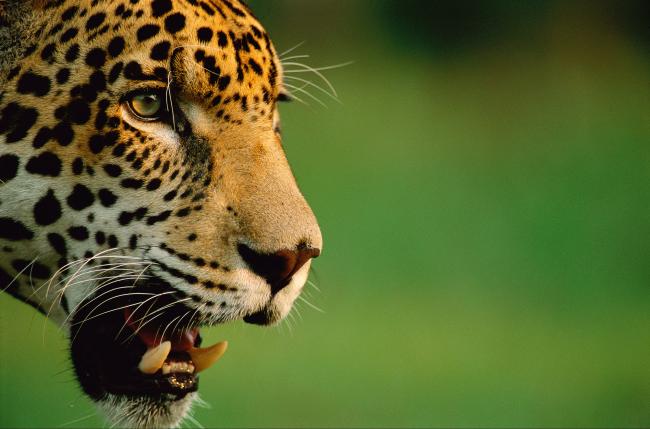
The base colors of jaguars are pale or sandy, though some jaguars are brown or black. These are melanistic jaguars known as black panthers. Talking about their spotty coat, the tan-colored fur is dotted with darker rose-like patterns which are known as rosetting. The rosetting is unique to each individual just as fingertips are unique to individual humans.
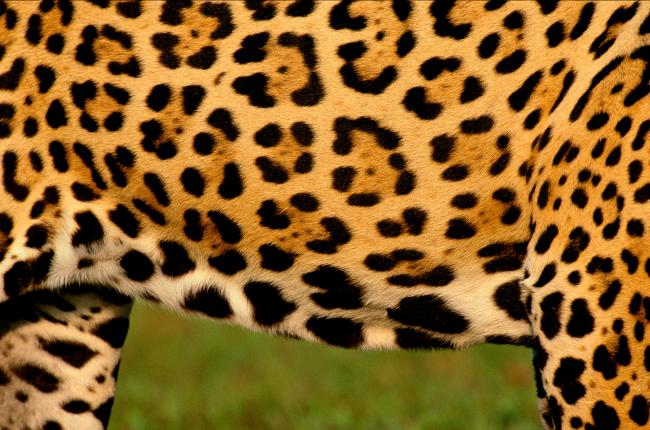
Jaguars have an excellent nocturnal vision like all cats have, which is improved by the tapetum (light-reflecting layer of cells at the back of the eye that enhances light). Jaguars are excellent swimmers and unlike other cats, they readily take to the water. They live near rivers and wetlands and during hunting jaguars cross the river several times or swim upstream or down for hundreds of yards. When hunting, jaguars move silently and when they do not hunt, they become loud and noisy.
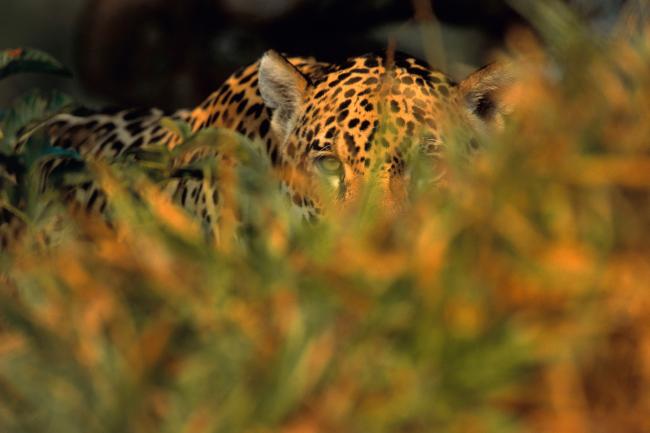
Distribution and Habitat: Jaguars at Rest
Jaguars inhabit the Western Hemisphere, primarily in the tropical rainforests of Central and South America, including much of Amazonian Brazil. As of current times, they are confined to remote pockets of rainforests particularly in the Amazon rainforest.

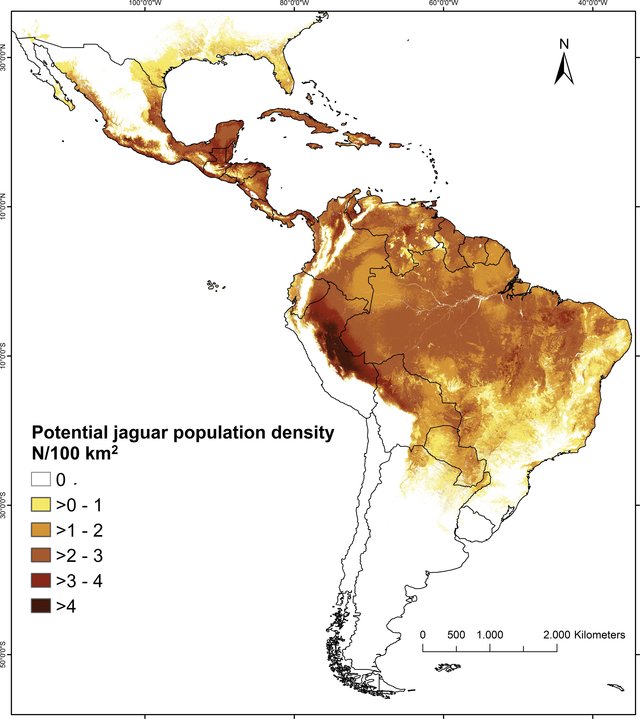
Jaguars tend to prefer riverine forests and as their hunting technique is skewed to stalk-and-ambush rather than chasing down the prey, the ideal habitat type is thick dense, moist forests. Those habitats support concealed lookouts in order to ambush prey. They are solitary and naturally inclined to settle in the close proximity of water and therefore can be found near permanent swamplands or seasonally flooded forests. Being a keystone species, jaguars are crucial to stabilizing ecosystems and as they are apex predators, they regulate prey populations.
An Alarm Call on Declining of Jaguars
Jaguars encounter a number of menaces, namely habitat loss, habitat fragmentation, poaching, human-wildlife conflict situations. Due to habitat fragmentation, the process by which a large expanse of habitat gets divided into smaller patches of habitats, the jaguars are unable to travel far to look for mates and this leads to inbreeding and local extinctions. Poachers hunt down jaguars for pelts and teeth and ranchers kill jaguars in order to safeguard their farming lands.
Jaguars are classified as near-threatened (NT) species by IUCN and effects have been taken to conserve the declining jaguar population by various personnel responsible. Jaguars are listed on CITES and therefore, the trading of jaguars or their body parts is strictly prohibited. Hunting jaguars is banned in Argentina, Brazil, Colombia, Panama, and several other countries as well.
International Day of Jaguars
Observed annually on November 29, International Jaguar Day depicts the high-priority necessity to conserve these keystone species in ecosystems. This Day educates and raises awareness on conserving jaguar corridors and their habitats.
“It takes time for jaguars to recover, and our new results demonstrate that persistence pays off.”
Joe Walston – The Wildlife Conservation Society (WCS), Executive Vice President for Global Conservation
All in all, jaguars are umbrella species with a decreasing population state since the early 1900s. calling attention to conserving these staggeringly beautiful rosette-coated beasts in the wild and strengthening law enforcement to protect them and their habitats is crucial if only we want them to stick around in the course of time.
Written By:
F. B. Ishara Nimeshi,
2nd Year Undergraduate,
Faculty of Science,
University of Colombo.
References:
- Jaguar. (n.d.). Animals. Retrieved January 6, 2022, from https://www.nationalgeographic.com/animals/mammals/facts/jaguar
- Jaguar Strategy 2020–2030. (n.d.). Estrategia_jaguar_2020_2030_wwf. Pdf. Retrieved January 6, 2022, from https://wwflac.awsassets.panda.org/downloads/estrategia_jaguar_2020_2030_wwf.pdf
- Jędrzejewski, W., Robinson, H. S., Abarca, M., Zeller, K. A., Velasquez, G., Paemelaere, E. A. D., Goldberg, J. F., Payan, E., Hoogesteijn, R., Boede, E. O., Schmidt, K., Lampo, M., Viloria, N. L., Carreño, R., Robinson, N., Lukacs, P. M., Nowak, J. J., Salom-Pérez, R., Castañeda, F., . . . Quigley, H. (2018). Estimating large carnivore populations at global scale based on spatial predictions of density and distribution – Application to the jaguar (Panthera onca). PLOS ONE, 13(3), e0194719. https://doi.org/10.1371/journal.pone.0194719
Image Courtesy:
- Title Image: https://bit.ly/3eYGbG9
- 1st Content Image: https://bit.ly/3n3Yb6G
- 2nd Content Image: https://bit.ly/34wq54V
- 3rd Content Image: https://bit.ly/31vl6QC
- 4th Content Image: https://bit.ly/3HD9QkE
- 5th Content Image: https://bit.ly/3eUrF27


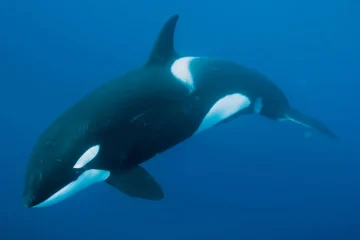
0 Comments